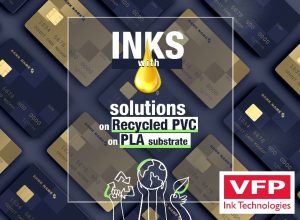The credit card market has taken a major shift toward more environmentally friendly payment solutions. Many banking institutions have committed to sustainability and are already working toward a net zero future. As per a key fact in a recent Insider Intelligence report, younger consumers who rate climate change as a much greater threat than their older peers do are far more likely to choose or switch banks according to their ethics or “purpose.”
Industry designers are adapting their products and manufacturing processes to meet this eco-friendly demand. Likewise, suppliers and consumables manufacturers have developed technical solutions that generate less plastic and paper waste. This reduces pollution and minimizes carbon emissions, to support banks in an eco-responsible approach.
The International Card Manufacturers Association (ICMA) member, VFP Ink Technologies, shares the latest global trends in plastic card manufacturing. VFP designs and manufactures high-tech industrial inks and varnishes for a wide range of applications, including laminated PVC cards.
Green Alternatives to Reduce Plastic Production
To reduce plastic production and replace first-use PVC, substrates manufacturers provide options including:
- Recycled sources like R-PVC or R-PET: These recycled substrates are made from waste that cannot be reused in the same process that generated the waste. They’re created by employing plastic waste from the packaging and printing industries. Cards can contain 80% less first-used PVC.
PVC as PET is well suited to recycling due to its advanced mechanical recycling properties, as well as large volumes of waste produced during their process of use. Recycling reduces the need for extracting (mining, quarrying and logging), refining and processing raw materials, while saving energy. It’s important to note that using recycled substrates also reduces greenhouse gas emissions, which helps to tackle climate change.
To avoid plastic waste, the use of alternative eco-friendly materials is another option and meets the growing demand for eco-friendly products.
- Renewable and biodegradable polymer material: This includes eco-friendly alternatives like poly lactic acid (PLA), which is a thermoplastic polymer produced by fermentation of a carbohydrate source such as corn starch. PLA is an eco-friendly card option because it’s biodegradable, recyclable and non-toxic if incinerated. PLA cards can contain 84% less fossil-based than PVC.
Another advantage of this bio-sourced material is that production uses about 65% less energy. It also causes considerably fewer pollutants, between 65 to 70% less emission of greenhouse gases, compared to classic petroleum-based PVC cards.
Since this substrate is compostable, disposal needs less energy and causes less pollution. The break-down in industrial composting facilities will require only two to three months. Furthermore, the process avoids the emission of toxic fumes by incineration, similar to other plastics.
Consumables Suppliers Offer Solutions
Consumables suppliers have a role to play in advancing solutions to new models of production and substrates alternatives. Both of these sustainable substrate solutions can replace PVC for the manufacturing of a credit card. However, they don’t have all the exact properties at the beginning.
There will be differences in the printability and in the mechanical characteristics between all of these substrate types. As such, it requires specific attention during the manufacturing process. The selection of the right ink is an important step to obtain the usual specification required for a credit card.
Inks Manufacturers Take on Sustainability
The quality of the final card can’t be achieved with any standard screen inks on these sustainable substrates, without leading to technical difficulties. Inks and varnishes designers, like VFP, labor and innovate in providing the most advanced solutions to the industry.
“VFP makes a major contribution to helping payment card manufacturers in their green commitments,” said Thierry Perrot, R&D chemist at VFP Ink Technologies. “During the last several decades, VFP has acquired critical knowledge in the credit card market through its R&D department and chemical engineers who worked on functional and technical product specifications. As a well-known screen ink manufacturer, VFP Ink Technologies joins the growing list of suppliers that are helping the credit cards market go green.”
Through its AQUACARD Hydro UV ink series, VFP offers an efficient technical solution that combines the two advantages of a low carbon emission and the ability of being printed on these specific materials. All without causing any further problems, unlike some other solvent based or UV curing inks would do.

In addition to its good adhesion properties on recycled PVC substrates, this hydro UV ink maintains a good flexibility with PLA substrate. This Hydro UV ink also has the interest to avoid VOC emission, during the printing process, compared to solvent-based ink. Additionally, it has better screen stability compared to water-based inks, which generally lead to more waste/change of screen emulsion.

Advantages of Using Renewable Resources
Cards made from plastic substitutes, which are created from renewable sources rather than petroleum prevent:
- Issues regarding supplying limited raw materials
- A shortage of polymer and additives that consequently lead to all-time record high prices
In conclusion, inks and varnishes suppliers can help card manufacturers stand out from the crowd and tailor solutions to meet sustainability needs. With its R&D team comprised of highly skilled chemical engineers, the inks and varnishes designers manufacture high-tech products designed for industrial use with cutting-edge technology.
More Insights on Card Trends
For more than 30 years, ICMA has represented the interests of the card manufacturing industry—which includes manufacturers, personalizers, issuers and suppliers—as its leading global association.
In response to consumer and card issuer demand for green transaction and identification cards, the ICMA EcoLabel Standard Program provides a determination of the environmental performance of a manufacturer’s cards through a third-party ecolabeling certification program. Manufacturers can become EcoLabel Program licensees to showcase their support of sustainability initiatives. Licensees can also offer clients a valuable EcoLabel opportunity for cards that meet established criteria in the following categories: reduced materials, recycled content, compostable and biobased content.
ICMA also offers regular educational opportunities, including virtual ACE-Commercial training, which provides sales, marketing, customer service and other key personnel at ICMA member companies with the opportunity to learn the fundamentals of card manufacturing.
Throughout the year, ICMA members have the opportunity to share insights and knowledge by giving presentations during ICMA webcasts and events. The association’s main event is its annual Card Manufacturing & Personalization EXPO.
Learn more about the benefits of an ICMA membership.
